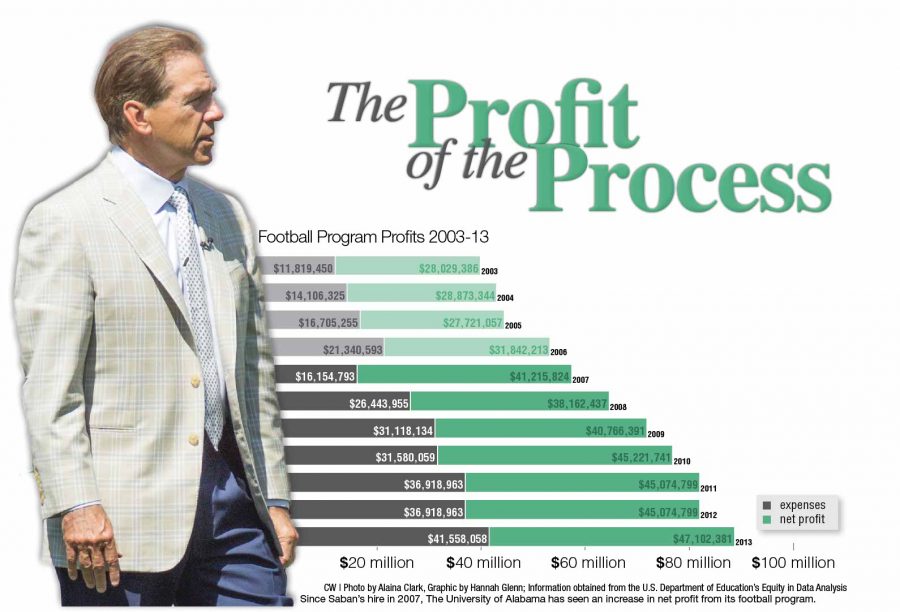Robert Witt and Paul Finebaum agree: Not all assets are a dab of ink on the balance sheet. One of them carries a whistle and wears a big straw hat to practice each day.
“Nick Saban is the best financial investment that this University has ever made,” University of Alabama System Chancellor Robert Witt said in an interview for a “60 Minutes” feature on Saban, titled “The Perfectionist.”
ESPN radio host Finebaum took Witt’s comparison one step further, framing Saban’s financial importance in historical proportions beyond the lifetime of the 180-plus year-old University.
“Actually, some might argue the $4 million paid to get rid of Mike Shula might be the school’s best investment ever,” Finebaum said in an emailed statement. “Seriously, Dr. Witt is correct. The money spent on Saban might be the best investment since the $24 spent to buy Manhattan in 1626.”
With Saban poised to collect $5,545,852 total pay for 2013 and a 2012 contract extension that will keep him in Tuscaloosa until Jan. 31, 2020, with annual $100,000 raises, the numbers clamor just as loudly as the commentators.
Mack Brown, head football coach at the University of Texas at Austin and the second-highest paid coach in college football behind Saban, will earn $5,453,750 total pay in 2013, according to USA Today, though the UT program had more in total revenue than Alabama in 2013.
UT Austin’s football program measured $109,400,688 in total revenues and $27,675,403 in total expenses for fiscal 2013, according to the U.S. Department of Education’s Equity in Data Analysis website. Crimson Tide football made less and spent more than UT that same year, reporting $88,660,439 in total revenues and $41,558,058 in total expenses the same year.
UT’s net profit of $81,725,285 nearly matches Alabama’s total football revenue. Still, Finebaum said Saban’s sole influence on his institution surpasses that of any other individual coach.
“I have never seen one man in the history of intercollegiate athletes impact a university more than Nick Saban. He has changed the culture, and remarkably he did it very quickly,” Finebaum said. “[Paul] “Bear” Bryant affected people greatly and still does, to a degree. But Saban’s influence is profound, particularly at a school that had already claimed college football’s greatest coach.”
According to the Equity in Data Analysis numbers, the football program’s total revenues for fiscal 2013 marked an estimated 67 percent increase from the $53,182,806 reported in 2006, Shula’s final season as head coach before Saban’s arrival at the University in 2007.
This climb in revenues has not come without a corresponding increase in costs: Over the same period, the football program’s total operating expenses have increased by approximately 95 percent. Still, revenues minus expenses for the past four seasons have averaged $44,541,328, margins 53 percent greater than the $29,116,500 average net income during the four years prior to Saban’s tenure.
“From a financial perspective, at Alabama, football generates about two-thirds of all revenues, which helps support all of our 21 teams,” Battle said.
According to Alabama’s 2011-12 financial report, net auxiliary sales and services “comprised of Intercollegiate Athletics, food service, housing, supply store, telecommunications and other miscellaneous auxiliary enterprises” totaled $140,948,823 for fiscal 2012. The football team’s 2012 net income of $45,074,799 alone accounts for 32 percent of the University’s auxiliary net income.
In a May 13 article for Forbes titled “The Magic of Nick Saban: Everyone Wants to Go to Alabama,” Tom Van Riper called Saban’s 2013 salary “modest,” citing measurable increases in enrollment since Saban’s arrival. Van Riper wrote, “To appreciate just how modest Saban’s $5.3 million salary is, take a wider look around campus.”
The Crimson Tide’s 73-13 official record under Saban’s leadership has people taking a wider look from around the country.
Alabama’s 2013 BCS National Championship Game victory over Notre Dame reported a Nielsen rating of 17.5, approximately 26.4 million viewers. The team’s appearances in the 2012 and 2010 BCS championship games against LSU and Texas recorded estimated national viewership of 24.2 million and 28.5 million, respectively. According to data from the 2010 U.S. Census, the state of Alabama’s population totals approximately 4.7 million.
All of those eyes have translated, at least indirectly, to applications for admission.
According to data provided by the Office of Institutional Research, the University’s out-of-state undergraduate enrollment has increased by 175 percent since 2006. Over the same period, total undergraduate enrollment has increased by 51 percent.
“Championship teams create demand for season tickets, provide greater television opportunities, provide bowl game opportunities, attract students to help grow the student body and attract donors who want to help support the athletic and academic interests of the University,” Battle said.









